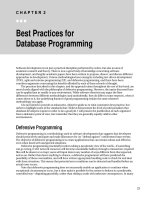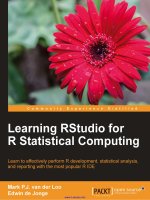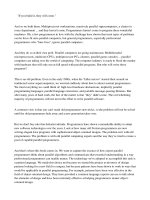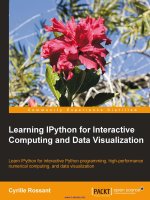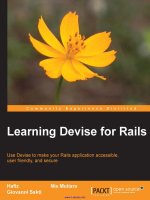learning ros for robotics programming
Bạn đang xem bản rút gọn của tài liệu. Xem và tải ngay bản đầy đủ của tài liệu tại đây (10.05 MB, 332 trang )
www.it-ebooks.info
Learning ROS for Robotics
Programming
A practical, instructive, and comprehensive guide
to introduce yourself to ROS, the top-notch, leading
robotics framework
Aaron Martinez
Enrique Fernández
BIRMINGHAM - MUMBAI
www.it-ebooks.info
Learning ROS for Robotics Programming
Copyright © 2013 Packt Publishing
All rights reserved. No part of this book may be reproduced, stored in a retrieval
system, or transmitted in any form or by any means, without the prior written
permission of the publisher, except in the case of brief quotations embedded in
critical articles or reviews.
Every effort has been made in the preparation of this book to ensure the accuracy
of the information presented. However, the information contained in this book is
sold without warranty, either express or implied. Neither the authors, nor Packt
Publishing, and its dealers and distributors will be held liable for any damages
caused or alleged to be caused directly or indirectly by this book.
Packt Publishing has endeavored to provide trademark information about all of the
companies and products mentioned in this book by the appropriate use of capitals.
However, Packt Publishing cannot guarantee the accuracy of this information.
First published: September 2013
Production Reference: 1190913
Published by Packt Publishing Ltd.
Livery Place
35 Livery Street
Birmingham B3 2PB, UK.
ISBN 978-1-78216-144-8
www.packtpub.com
Cover Image by Duraid Fatouhi ()
www.it-ebooks.info
Credits
Authors
Aaron Martinez
Enrique Fernández
Reviewers
Luis Sánchez Crespo
Matthieu Keller
Damian Melniczuk
Acquisition Editors
Kartikey Pandey
Rubal Kaur
Lead Technical Editor
Susmita Panda
Technical Editors
Jalasha D'costa
Amit Ramadas
Project Coordinator
Abhijit Suvarna
Proofreader
Joanna McMahon
Copy Editors
Alda Paiva
Mradula Hegde
Gladson Monteiro
Sayanee Mukherjee
Adithi Shetty
Indexers
Hemangini Bari
Rekha Nair
Graphics
Ronak Dhruv
Production Coordinator
Manu Joseph
Cover Work
Manu Joseph
www.it-ebooks.info
About the Authors
Aaron Martinez is a computer engineer, entrepreneur, and expert in digital
fabrication. He did his Master's thesis in 2010 at the IUCTC (Instituto Universitario
de Ciencias y Tecnologias Ciberneticas) in the University of Las Palmas de Gran
Canaria. He prepared his Master's thesis in the eld of telepresence using immersive
devices and robotic platforms. After completing his academic career, he attended an
internship program at The Institute for Robotics in the Johannes Kepler University in
Linz, Austria. During his internship program, he worked as part of a development
team of a mobile platform using ROS and the navigation stack. After that, he was
involved in some projects related to robotics, one of them is the AVORA project
in the University of Las Palmas de Gran Canaria. In this project, he worked on the
creation of an AUV (Autonomous Underwater Vehicle) to participate in the Student
Autonomous Underwater Challenge-Europe (SAUC-E) in Italy. In 2012, he was
responsible for manufacturing this project; in 2013, he helped to adapt the navigation
stack and other algorithms from ROS to the robotic platform.
Recently, Aaron created his own company called Biomecan. This company works
with projects related to robotics, manufacturing of prototypes, and engineering
tissue. The company manufactures devices for other companies and research and
development institutes. For the past two years, he has been working on engineering
tissue projects, creating a new device to help researchers of cell culture.
Aaron has experience in many elds such as programming, robotics, mechatronics,
and digital fabrication, many devices such as Arduino, BeagleBone, Servers, and
LIDAR, servomotors, and robotic platforms such as Wibot, Nao Aldebaran, and
Pioneer P3AT.
www.it-ebooks.info
I would like to thank my girlfriend who has supported me while
writing this book and gave me motivation to continue growing
professionally. I also want to thank Donato Monopoli, Head of
Biomedical Engineering Department at ITC (Canary-Islands Institute
of Technology), and all the staff there. Thanks for teaching me all
I know about digital fabrication, machinery, and engineering tissue.
I spent the best years of my life in your workshop.
Thanks to my colleagues in the university, especially Alexis Quesada,
who gave me the opportunity to create my rst robot in my Master's
thesis. I have learned a lot about robotics working with them.
Finally, thanks to my family and friends for their help and support.
Enrique Fernández is a computer engineer and roboticist. He did his Master's
Thesis in 2009 at the University Institute of Intelligent Systems and Computational
Engineering in the University of Las Palmas de Gran Canaria. There he has been
working on his Ph.D for the last four years; he is expected to become a Doctor in
Computer Science by September 2013. His Ph.D addresses the problem of Path
Planning for Autonomous Underwater Gliders, but he has also worked on other
robotic projects. He participated in the Student Autonomous Underwater
Challenge-Europe (SAUC-E) in 2012, and collaborated for the 2013 edition. In 2012,
he was awarded a prize for the development of an underwater pan-tilt vision system.
Now, Enrique is working for Pal-Robotics as a SLAM engineer. He completed his
internship in 2012 at the Center of Underwater Robotics Research in the University
of Girona, where he developed SLAM and INS modules for the Autonomous
Underwater Vehicles of the research group using ROS. He joined Pal-Robotics
in June 2013, where he is working with REEM robots using the ROS software
intensively and developing new navigation algorithms for wheeled and biped
humanoid robots, such as the REEM-H3 and REEM-C.
www.it-ebooks.info
During his Ph.D, Enrique has published several conference papers and publications.
Two of these were sent to the International Conference of Robotics and Automation
(ICRA) in 2011. He is the co-author of some chapters of this book, and his Master's
Thesis was about the FastSLAM algorithm for indoor robots using a SICK laser
scanner and the odometry of a Pioneer differential platform. He also has experience
with electronics and embedded systems, such as PC104 and Arduino. His background
covers SLAM, Computer Vision, Path Planning, Optimization, and Robotics and
Articial Intelligence in general.
I would like to thank my colleagues in the AVORA team, which
participated in the SAUC-E competition, for their strong collaboration
and all the things we learned. I also want to thank the members of
my research group at the University Institute of Intelligent Systems
and Computational Engineering and the people of the Center
of Underwater Robotics Research in Girona. During that time, I
expended some of the most productive days of my life; I have learned
a lot about robotics and had the chance to learn player/stage/Gazebo
and start with ROS. Also, thanks to my colleagues in Pal-Robotics,
who have received me with open arms, and have given me the
opportunity to learn even more about ROS and (humanoid) robots.
Finally, thanks to my family and friends for their help and support.
www.it-ebooks.info
About the Reviewers
Luis Sánchez Crespo has completed his dual Master's degree in Electronics and
Telecommunication Engineering at the University of Las Palmas de Gran Canaria.
He has collaborated with different research groups as the Institute for Technological
Development and Innovation (IDETIC), the Oceanic Platform of Canary Islands
(PLOCAN), and the Institute of Applied Microelectronics (IUMA) where he actually
researches on imaging super-resolution algorithms.
His professional interests lie in computer vision, signal processing, and electronic
design applied on robotics systems. For this reason, he joined the AVORA team, a
group of young engineers and students working on the development of Underwater
Autonomous Vehicles (AUV) from scratch. Inside this project, Luis has started
developing acoustic and computer vision systems, extracting information from
different sensors such as hydrophones, SONAR, or camera. He has also been
involved in the electronic design of the vehicle. Finally, he has played the Team
Leader role during the preparation of the SAUC-E'13 challenge.
With a strong background gained in marine technology, Luis joined Biomecan, a
young startup, where he works on developing remotely operated and autonomous
vehicles for aquatic environments.
He is very enthusiastic and an engineer in multiple disciplines. He is responsible for
his work. He can manage himself and can take up responsibilities as a Team Leader, as
demonstrated at the SAUC-E competition directing the AVORA team. His background
in electronics and telecommunications allows him to cover a wide range of expertise
from signal processing and software, to electronic design and fabrication.
www.it-ebooks.info
He has focused his career in 2D and 3D signal processing, with the development
of a system for tracking and detecting signs of exhaustion and the risk of falling
asleep in drivers. After this successful research, he started working on two different
projects at the same time. The rst of these projects focused mainly on achieving
video sequences enhancement applying super-resolution. The second project, and
one of his most important achievements, was participating in the development
of an autonomous underwater vehicle for the Students Autonomous Underwater
Challenge-Europe (SAUC-E) in which his team achieved great recognition with
the fourth most important prize. In his second year, he took up the mantle of
Team Leader, again being recognized by his work during competition.
I would like to thank my family for supporting me since my
rst step, Guaxara for lighting my path, and my teammates for
supporting me. I would also like to thank Dario Sosa Cabrera
and Anil Motilal Mahtani Mirchandani.
Matthieu Keller is a French student who has completed several internships in
development, system administration, and cyber security. His education is mainly
in Computer Science and Robotics, but he enjoys all kinds of scientic topics.
Damian Melniczuk graduated with Physics from the Wrocław University of
Technology, where he currently works in the quantum cryptography laboratory.
Apart from using photons for transporting encryption keys, he is also involved
in hacker culture and open source movement. His current projects are: setting up
Wroclaw Hackerspace ( and building an open source modular
home automation system ( />www.it-ebooks.info
www.PacktPub.com
Support les, eBooks, discount offers and more
You might want to visit www.PacktPub.com for support les and downloads related
to your book.
Did you know that Packt offers eBook versions of every book published, with PDF
and ePub les available? You can upgrade to the eBook version at
www.PacktPub.
com
and as a print book customer, you are entitled to a discount on the eBook copy.
Get in touch with us at for more details.
At
www.PacktPub.com, you can also read a collection of free technical articles, sign
up for a range of free newsletters and receive exclusive discounts and offers on Packt
books and eBooks.
TM
Do you need instant solutions to your IT questions? PacktLib is Packt's online
digital book library. Here, you can access, read and search across Packt's entire
library of books.
Why Subscribe?
• Fully searchable across every book published by Packt
• Copy and paste, print and bookmark content
• On demand and accessible via web browser
Free Access for Packt account holders
If you have an account with Packt at www.PacktPub.com, you can use this to access
PacktLib today and view nine entirely free books. Simply use your login credentials
for immediate access.
www.it-ebooks.info
www.it-ebooks.info
Table of Contents
Preface 1
Chapter 1: Getting Started with ROS 7
Installing ROS Electric – using repositories 10
Adding repositories to your sources.list le 12
Setting up your keys 12
Installation 12
The environment setup 13
Installing ROS Fuerte – using repositories 14
Conguring your Ubuntu repositories 14
Setting up your source.list le 15
Setting up your keys 15
Installation 15
The environment setup 17
Standalone tools 18
How to install VirtualBox and Ubuntu 18
Downloading VirtualBox 19
Creating the virtual machine 19
Summary 23
Chapter 2: The ROS Architecture with Examples 25
Understanding the ROS Filesystem level 26
Packages 27
Stacks 29
Messages 29
Services 31
Understanding the ROS Computation Graph level 32
Nodes 34
Topics 35
Services 36
www.it-ebooks.info
Table of Contents
[ ii ]
Messages 37
Bags 37
Master 38
Parameter Server 38
Understanding the ROS Community level 39
Some tutorials to practice with ROS 39
Navigating through the ROS lesystem 39
Creating our own workspace 40
Creating an ROS package 41
Building an ROS package 42
Playing with ROS nodes 42
Learning how to interact with topics 45
Learning how to use services 49
Using the Parameter Server 51
Creating nodes 52
Building the node 55
Creating msg and srv les 57
Using the new srv and msg les 58
Summary 62
Chapter 3: Debugging and Visualization 63
Debugging ROS nodes 66
Using the GDB debugger with ROS nodes 66
Attaching a node to GDB while launching ROS 67
Enabling core dumps for ROS nodes 68
Debugging messages 69
Outputting a debug message 69
Setting the debug message level 70
Conguring the debugging level of a particular node 71
Giving names to messages 72
Conditional and ltered messages 73
More messages – once, throttle, and combinations 74
Using rosconsole and rxconsole to modify the debugging level on the y 75
Inspecting what is going on 80
Listing nodes, topics, and services 80
Inspecting the node's graph online with rxgraph 80
When something weird happens – roswtf! 83
Plotting scalar data 83
Creating a time series plot with rxplot 84
Other plotting utilities – rxtools 86
www.it-ebooks.info
Table of Contents
[ iii ]
Visualization of images 87
Visualizing a single image 87
FireWire cameras 88
Working with stereo vision 90
3D visualization 91
Visualizing data on a 3D world using rviz 92
The relationship between topics and frames 94
Visualizing frame transformations 94
Saving and playing back data 96
What is a bag le? 97
Recording data in a bag le with rosbag 98
Playing back a bag le 99
Inspecting all the topics and messages in a bag le using rxbag 100
rqt plugins versus rx applications 102
Summary 102
Chapter 4: Using Sensors and Actuators with ROS 103
Using a joystick or gamepad 104
How does joy_node send joystick movements? 105
Using joystick data to move a turtle in turtlesim 106
Using a laser rangender – Hokuyo URG-04lx 110
Understanding how the laser sends data in ROS 111
Accessing the laser data and modifying it 113
Creating a launch le 115
Using the Kinect sensor to view in 3D 116
How does Kinect send data from the sensors and how to see it? 117
Creating an example to use Kinect 119
Using servomotors – Dynamixel 121
How does Dynamixel send and receive commands for the movements? 123
Creating an example to use the servomotor 124
Using Arduino to add more sensors and actuators 125
Creating an example to use Arduino 126
Using the IMU – Xsens MTi 129
How does Xsens send data in ROS? 130
Creating an example to use Xsens 131
Using a low-cost IMU – 10 degrees of freedom 133
Downloading the library for the accelerometer 135
Programming Arduino Nano and the 10DOF sensor 135
Creating a ROS node to use data from the 10DOF sensor 138
Summary 140
www.it-ebooks.info
Table of Contents
[ iv ]
Chapter 5: 3D Modeling and Simulation 141
A 3D model of our robot in ROS 141
Creating our rst URDF le 142
Explaining the le format 144
Watching the 3D model on rviz 145
Loading meshes to our models 147
Making our robot model movable 148
Physical and collision properties 149
Xacro – a better way to write our robot models 150
Using constants 151
Using math 151
Using macros 151
Moving the robot with code 152
3D modeling with SketchUp 156
Simulation in ROS 158
Using our URDF 3D model in Gazebo 159
Adding sensors to Gazebo 162
Loading and using a map in Gazebo 163
Moving the robot in Gazebo 165
Summary 168
Chapter 6: Computer Vision 171
Connecting and running the camera 173
FireWire IEEE1394 cameras 174
USB cameras 178
Making your own USB camera driver with OpenCV 180
Creating the USB camera driver package 181
Using the ImageTransport API to publish the camera frames 182
Dealing with OpenCV and ROS images using cv_bridge 186
Publishing images with ImageTransport 187
Using OpenCV in ROS 188
Visualizing the camera input images 188
How to calibrate the camera 188
Stereo calibration 193
The ROS image pipeline 198
Image pipeline for stereo cameras 201
ROS packages useful for computer vision tasks 204
Performing visual odometry with viso2 205
Camera pose calibration 206
www.it-ebooks.info
Table of Contents
[ v ]
Running the viso2 online demo 210
Running viso2 with our low-cost stereo camera 213
Summary 214
Chapter 7: Navigation Stack – Robot Setups 215
The navigation stack in ROS 216
Creating transforms 217
Creating a broadcaster 218
Creating a listener 218
Watching the transformation tree 221
Publishing sensor information 222
Creating the laser node 223
Publishing odometry information 226
How Gazebo creates the odometry 227
Creating our own odometry 230
Creating a base controller 234
Using Gazebo to create the odometry 236
Creating our base controller 238
Creating a map with ROS 241
Saving the map using map_server 243
Loading the map using map_server 244
Summary 245
Chapter 8: Navigation Stack – Beyond Setups 247
Creating a package 248
Creating a robot conguration 248
Conguring the costmaps (global_costmap) and (local_costmap) 251
Conguring the common parameters 251
Conguring the global costmap 253
Conguring the local costmap 253
Base local planner conguration 254
Creating a launch le for the navigation stack 255
Setting up rviz for the navigation stack 256
2D pose estimate 257
2D nav goal 258
Static map 258
Particle cloud 259
Robot footprint 260
Obstacles 261
Inated obstacles 262
www.it-ebooks.info
Table of Contents
[ vi ]
Global plan 262
Local plan 263
Planner plan 264
Current goal 264
Adaptive Monte Carlo Localization (AMCL) 266
Avoiding obstacles 268
Sending goals 269
Summary 273
Chapter 9: Combining Everything – Learn by Doing 275
REEM – the humanoid of PAL Robotics 276
Installing REEM from the ofcial repository 278
Running REEM using the Gazebo simulator 282
PR2 – the Willow Garage robot 284
Installing the PR2 simulator 285
Running PR2 in simulation 285
Localization and mapping 289
Running the demos of the PR2 simulator 292
Robonaut 2 – the dexterous humanoid of NASA 293
Installing the Robonaut 2 from the sources 293
Running Robonaut 2 in the ISS xed pedestal 294
Controlling the Robonaut 2 arms 295
Controlling the robot easily with interactive markers 295
Giving legs to Robonaut 2 297
Loading the ISS environment 298
Husky – the rover of Clearpath Robotics 299
Installing the Husky simulator 300
Running Husky on simulation 300
TurtleBot – the low-cost mobile robot 302
Installing the TurtleBot simulation 302
Running TurtleBot on simulation 303
Summary 303
Index 305
www.it-ebooks.info
Preface
Learning ROS for Robotics Programming gives you a comprehensive review of ROS
tools. ROS is the Robot Operating System framework, which is used nowadays by
hundreds of research groups and companies in the robotics industry. But it is also
the painless entry point to robotics for nonprofessional people. You will see how
to install ROS, start playing with its basic tools, and you will end up working with
state-of-the-art computer vision and navigation tools.
The content of the book can be followed without any special devices, and each
chapter comes with a series of source code examples and tutorials that you can
run on your own computer. This is the only thing you need to follow in the book.
However, we also show you how to work with hardware, so that you can connect
your algorithms with the real world. Special care has been taken in choosing
devices which are affordable for amateur users, but at the same time the most
typical sensors or actuators in robotics research are covered.
Finally, the potential of ROS is illustrated with the ability to work with whole
robots in a simulated environment. You will learn how to create your own robot
and integrate it with the powerful navigation stack. Moreover, you will be able to
run everything in simulation, using the Gazebo simulator. We will end the book
by providing a list of real robots available for simulation in ROS. At the end of the
book, you will see that you can work directly with them and understand what is
going on under the hood.
www.it-ebooks.info
Preface
[ 2 ]
What this book covers
Chapter 1, Getting Started with ROS, shows the easiest way you must follow in
order to have a working installation of ROS. You will see how to install different
distributions of ROS, and you will use ROS Fuerte in the rest of the book. How to
make an installation from Debian packages or compiling the sources, as well as
making installations in virtual machines, have been described in this chapter.
Chapter 2, The ROS Architecture with Examples, is concerned with the concepts and tools
provided by the ROS framework. We will introduce you to nodes, topics, and services,
and you will also learn how to use them. Through a series of examples, we will
illustrate how to debug a node or visualize the messages published through a topic.
Chapter 3, Debugging and Visualization, goes a step further in order to show you
powerful tools for debugging your nodes and visualize the information that goes
through the node's graph along with the topics. ROS provides a logging API which
allows you to diagnose node problems easily. In fact, we will see some powerful
graphical tools such as rxconsole and rxgraph, as well as visualization interfaces
such as rxplot and rviz. Finally, this chapter explains how to record and playback
messages using rosbag and rxbag.
Chapter 4, Using Sensors and Actuators with ROS, literally connects ROS with the
real world. This chapter goes through a number of common sensors and actuators
that are supported in ROS, such as range lasers, servo motors, cameras, RGB-D
sensors, and much more. Moreover, we explain how to use embedded systems
with microcontrollers, similar to the widely known Arduino boards.
Chapter 5, 3D Modeling and Simulation, constitutes one of the rst steps in order to
implement our own robot in ROS. It shows you how to model a robot from scratch
and run it in simulation using the Gazebo simulator. This will later allow you to use
the whole navigation stack provided by ROS and other tools.
Chapter 6, Computer Vision, shows the support for cameras and computer vision tasks
in ROS. This chapter starts with drivers available for FireWire and USB cameras, so
that you can connect them to your computer and capture images. You will then be
able to calibrate your camera using ROS calibration tools. Later, you will be able to use
the image pipeline, which is explained in detail. Then, you will see how to use several
APIs for vision and integrate OpenCV. Finally, the installation and usage of a visual
odometry software is described.
Chapter 7, Navigation Stack – Robot Setups, is the rst of two chapters concerned with
the ROS navigation stack. This chapter describes how to congure your robot so
that it can be used with the navigation stack. In the same way, the stack is explained,
along with several examples.
www.it-ebooks.info
Preface
[ 3 ]
Chapter 8, Navigation Stack – Beyond Setups, continues the discussion of the previous
chapter by showing how we can effectively make our robot navigate autonomously. It
will use the navigation stack intensively for that. This chapter shows the great potential
of ROS using the Gazebo simulator and rviz to create a virtual environment in which
we can build a map, localize our robot, and do path planning with obstacle avoidance.
Chapter 9, Combining Everything – Learn by Doing, builds from the previous chapters
and shows a number of robots which are supported in ROS using the Gazebo
simulator. In this chapter you will see how to run these robots in simulation and
perform several of the tasks learned in the rest of the book, especially those related
to the navigation stack.
What you need for this book
This book was written with the intention that almost everybody can follow it and
run the source code examples provided with it. Basically, you need a computer with a
Linux distribution. Although any Linux distribution should be ne, it is recommended
that you use a recent version of Ubuntu. Then you will use ROS Fuerte, which is
installed according to the instructions given in Chapter 1, Getting Started with ROS.
For this distribution of ROS, you will need a version of Ubuntu prior to 12.10
because since this version Fuerte is no longer supported.
Regarding the hardware requirements of your computer, in general any computer
or laptop is enough. However, it is advisable to use a dedicated graphic card in
order to run the Gazebo simulator. Also, it will be good to have a good number
of peripherals, so that you can connect several sensors and actuators, including
cameras and Arduino boards.
You will also need Git (the
git-core Debian package) in order to clone the repository
with the source code provided with this book. Similarly, you are expected to have
a basic knowledge of the Bash command line, GNU/Linux tools, and some C/C++
programming skills.
Who this book is for
This book is targeted at all robotics developers, from amateurs to professionals. It
covers all the aspects involved in a whole robotic system and shows how ROS helps
with the task of making a robot really autonomous. Anyone who is learning robotics
and has heard about ROS but has never tried it will benet from this book. Also, ROS
beginners will learn advance concepts and tools of this framework. Indeed, even
regular users may learn something new from some particular chapters. Certainly,
only the rst three chapters are intended for new users; so those who already use
ROS may skip these ones and go directly to the rest.
www.it-ebooks.info
Preface
[ 4 ]
Conventions
In this book, you will nd a number of styles of text that distinguish between
different kinds of information. Here are some examples of these styles, and an
explanation of their meanings.
Code words in text are shown as follows: "The
*-ros-pkg contributed packages
are licensed under a variety of open source licenses."
A block of code is set as follows:
<package>
<description brief="short description">
long description,
</description>
<author>Aaron Martinez, Enrique Fernandez</author>
<license>BSD</license>
<url> />
<depend package="roscpp"/>
<depend package="common"/>
<depend package="otherPackage"/>
<versioncontrol type="svn" url="https://urlofpackage/trunk"/>
<export>
<cpp cflags="-I${prefix}/include" lflags="-L${prefix}/lib -lros"/>
</package>
When we wish to draw your attention to a particular part of a code block,
the relevant lines or items are set in bold:
<launch>
<node pkg="chapter3_tutorials" type="example1"
name="example1" output="screen"
launch-prefix="xterm -e gdb args"/>
</launch>
Any command-line input or output is written as follows:
$ rosrun book_tutorials tutorialX _param:=9.0
New terms and important words are shown in bold. Words that you see on the screen,
in menus, or dialog boxes for example, appear in the text like this: "We must have
clicked on the Play button at least once."
www.it-ebooks.info
Preface
[ 5 ]
Warnings or important notes appear in a box like this.
Tips and tricks appear like this.
Reader feedback
Feedback from our readers is always welcome. Let us know what you think about
this book—what you liked or may have disliked. Reader feedback is important for
us to develop titles that you really get the most out of.
To send us general feedback, simply send an e-mail to
,
and mention the book title via the subject of your message.
If there is a topic that you have expertise in and you are interested in either writing
or contributing to a book, see our author guide on
www.packtpub.com/authors.
Customer support
Now that you are the proud owner of a Packt book, we have a number of things to
help you to get the most from your purchase.
Downloading the example code
You can download the example code les for all Packt books you have purchased
from your account at . If you purchased this book
elsewhere, you can visit and register to
have the les e-mailed directly to you. You can also download these code les from
/>Downloading the color images of this book
We also provide you a PDF le that has color images of the screenshots/diagrams
used in this book. The color images will help you better understand the changes in
the output. You can download this le from />default/files/downloads/1448OS_Graphics.pdf
.
www.it-ebooks.info
Preface
[ 6 ]
Errata
Although we have taken every care to ensure the accuracy of our content, mistakes
do happen. If you nd a mistake in one of our books—maybe a mistake in the text or
the code—we would be grateful if you would report this to us. By doing so, you can
save other readers from frustration and help us improve subsequent versions of this
book. If you nd any errata, please report them by visiting ktpub.
com/submit-errata
, selecting your book, clicking on the errata submission form link,
and entering the details of your errata. Once your errata are veried, your submission
will be accepted and the errata will be uploaded on our website, or added to any list of
existing errata, under the Errata section of that title. Any existing errata can be viewed
by selecting your title from />Piracy
Piracy of copyright material on the Internet is an ongoing problem across all media.
At Packt, we take the protection of our copyright and licenses very seriously. If you
come across any illegal copies of our works, in any form, on the Internet, please
provide us with the location address or website name immediately so that we can
pursue a remedy.
Please contact us at
with a link to the suspected
pirated material.
We appreciate your help in protecting our authors, and our ability to bring
you valuable content.
Questions
You can contact us at if you are having a problem with
any aspect of the book, and we will do our best to address it.
www.it-ebooks.info
Getting Started with ROS
Welcome to the rst chapter of this book where you will learn how to install ROS,
the new standard software framework in robotics. With ROS, you will start to
program and control your robots the easy way using tons of examples and source
code that will show you how to use sensors and devices or add new functionalities
to your robot, such as autonomous navigation and visual perception. Thanks to
the open source motto and the community that is developing the state-of-the-art
algorithms and providing new functionalities, ROS is growing every day.
In this book you will learn the following:
• Installing the ROS framework on a version of Ubuntu
• Learning the basic operation of ROS
• Debugging and visualizing the data
• Programming your robot using this framework
• Creating a 3D model to use it in the simulator
• Using the navigation stack to make your robot autonomous
In this chapter we are going to install a full version of ROS in Ubuntu. We will
use Ubuntu because it is fully supported by and recommended for ROS. However,
you can use a different operating system instead of Ubuntu, but in these operative
systems, ROS is still experimental and could have some errors. So, for this reason,
we recommend you to use Ubuntu while you follow the samples in this book.
Before starting with the installation, we are going to learn the origin of ROS and
its history.
www.it-ebooks.info
Getting Started with ROS
[ 8 ]
Robot Operating System (ROS) is a framework that is widely used in robotics. The
philosophy is to make a piece of software that could work in other robots by making
little changes in the code. What we get with this idea is to create functionalities that
can be shared and used in other robots without much effort so that we do not reinvent
the wheel.
ROS was originally developed in 2007 by the Stanford Articial Intelligence
Laboratory (SAIL) with the support of the Stanford AI Robot project. As of 2008,
development continues primarily at Willow Garage, a robotics research institute,
with more than 20 institutions collaborating within a federated development model.
A lot of research institutions have started to develop projects in ROS by adding
hardware and sharing their code samples. Also, the companies have started to adapt
their products to be used in ROS. In the following image, you can see some fully
supported platforms. Normally, these platforms are published with a lot of code,
examples, and simulators to permit the developers to start their work easily.
The sensors and actuators used in robotics have also been adapted to be used with
ROS. Every day an increasing number of devices are supported by this framework.
ROS provides standard operating system facilities such as hardware abstraction,
low-level device control, implementation of commonly used functionalities,
message passing between processes, and package management. It is based on
graph architecture with a centralized topology where processing takes place in
nodes that may receive or post, such as multiplex sensor, control, state, planning,
actuator, and so on. The library is geared towards a Unix-like system (Ubuntu
Linux is listed as supported while other variants such as Fedora and Mac OS X
are considered experimental).
www.it-ebooks.info
